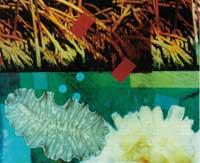“If briostatin 1 entered the market it would cost a billion dollars a year”
1997/10/01 Pain, Stepahie Iturria: Elhuyar aldizkaria
Marine bacteria are less prone to cooperation than their invertebrate hosts. Most of them have been impossible to grow and the hard work of looking for interesting chemicals. “We have to start by seeing how to grow,” says Fenical. “The concepts of bacterial growth are based on work done with microbial path.”
The approach the Harbor Branch group is exploring with One Cell Systems (a Massachusetts company) is to introduce individual bacteria into small polysaccharide spheres by imitating their natural conditions. According to Pat McGrath of One Cell, once the bacteria are inside your microsphere, you can manipulate the medium to see if it gives off something interesting.
If it is not possible to grow bacteria, there are other alternatives. In the small biotechnology company Cherichia coli in San Diego, researchers have achieved the biosynthetic pathway of marine microorganisms and introduced Escherichia coli or Streptomyces bacteria, such as the fungus Aspergillus, into easily growing beings. As Michael Dickman, president of the company says: “You can capture the genetic path of the chemical.” So, the catering agencies are responsible for developing the chemical. The company is currently using this technique to accelerate the screening process. The genetic engineers of the marine microorganism capture the DNA, introduce it into the various hoteliers and observe the chemical they produce.
Xome is the name that is being used to mix and match the genes of different species. Although the enzymes that produce these genes do not appear in nature at the same time, the Xome Chulas incorporates them mixed into the E. coli cell. Dickman states that “this allows us to find really new chemicals.”
The disadvantage of most of these strategies is that they often go far behind drug explorers. While drug companies are looking for faster ways to screen microorganisms for jobs like Chome, few companies are willing to invest in invertebrate research to ensure they have at least one suitable product. If briostatin 1-1 entered the drug market, the annual trillion would cost $1. But that “yes” is very big. The possible drug may reach the final phase of clinical research, but then explain the side effects. It may also happen that the drug is good, but that it offers no advantage over current therapies.
If companies don't want to pay, most researchers think that work corresponds to government institutions like the National Institute of Health. The U.S. National Cancer Institute and the Department of Agriculture, once proven to be good, have funded small research. Meanwhile, who knows what kind of damage has caused the massive collection of animals like Ecteinascidia? According to Bingham, “we know very little about the populations that are thoroughly exploited.”
The risk is, of course, to keep it as a promise until the chemists achieve their synthesis or the aquaculturists learn to grow. “And if Ecteinascidia gets it, what?” asks Wrigth. “If I had cancer, I would be the first to use it.” If the animals disappeared, this option would not be either.

Gai honi buruzko eduki gehiago
Elhuyarrek garatutako teknologia





